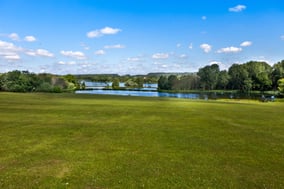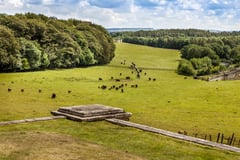Creating a natural asset strategy
Mr Hasell began the natural capital strategy at Castle Howard in 2020 with a financial review of the estate to help establish a baseline of its natural assets.
Firstly, areas where financial gross margins were lower or breakeven were identified as possible starting points for enhancements to their natural capital value.
The LAND360 team from Fera Science were brought in during 2021, applying our natural capital assessment tool to provide environmental insights.
This involved assessing the biodiversity and carbon footprint of the 9,000-acre (3,520ha) estate, using satellite technology, detailed mapping and verification by ecologists on the ground.
 In total we identified 6,093 habitat units – which included swathes of hedgerow, woodland, meadow, pasture and arable land. Applying UKHab codes to classify the quality and status of each habitat unit, we created a baseline of the potential biodiversity net gain and carbon capture.
In total we identified 6,093 habitat units – which included swathes of hedgerow, woodland, meadow, pasture and arable land. Applying UKHab codes to classify the quality and status of each habitat unit, we created a baseline of the potential biodiversity net gain and carbon capture.
Read more detail on the process undertaken at Castle Howard to create a natural capital baseline
Generating income from natural capital
Fera Science environmental economist Dr Glyn Jones explains why establishing this accurate picture of a farm or estate was a vital first step for Castle Howard to generate income from natural assets.
“There is public and private funding on offer for estate managers to invest in biodiversity or carbon reduction, however these deals will be based on a habitat’s potential for additional biodiversity net gain or carbon sequestration,” he says.
“Without having a mapped, authenticated baseline – hedgerow-by-hedgerow, margin-by-margin – landowners won’t be able to demonstrate this potential for improvement, and so won’t be in a strong position to negotiate and optimise value for themselves.”
Environmental projects being considered at Castle Howard
Following the LAND360 natural capital baselining process, the estate management team has identified several environmental projects that could yield public goods.
- Hall Moor habitat creation
A 40ha mosaic of pasture, arable, watercourses, mixed species of native wood and scrub, this was earmarked by Mr Hasell during the initial phases of the baselining process as a breakeven, low-yielding area.
With the Environment Bank, the estate team has co-designed a habitat creation plan which is being considered. To encourage wildlife biodiversity, this proposes to extend “lobes” of woodland into the arable land and pasture, allow scrub to generate in the margins, and widen a watercourse to slow its flow.
Biodiversity net gain credits pay about £950/ha a year for a 30-year period for this type of project. Further income could be generated through an option to retain conservation grazing on the pastureland and overlay other activities such as eco-tourism.
Commercial-scale trials of novel tree-planting approaches have been established, including the use of biodegradable tree guards on 1.6ha of woodland, enabled through Farming in Protected Landscapes funding.
This project helps to add another element of wildlife habitat and, long-term, harvesting the timber in a sustainable way presents another income stream for the estate.
The Castle Howard farmland managers are trialling leaving land in fallow, using new cover crop mixes and assessing minimum tillage drills. Longer-term intercropping options and agroforestry are being considered too.
The expansion of the estate’s successful tree nursery is ongoing. This includes taking on additional land and implementing automation to help improve process efficiencies.
The total carbon footprint is constantly being measured to support the move towards net zero. The team are also looking at options to offset carbon generated by visitors travelling to the estate through tree planting.
- Encouraging environmental R&D projects
Castle Howard has provided access for researchers from Fera Science, Newcastle University, York University and British Grassland Society. This includes projects on soil monitoring, 3D drone mapping of hedges and monitoring insects.
Ideas for achieving environmental targets on farmland and estates
Mr Hasell is the first to recognise that, because of its scale, income diversity and historical footing, the Castle Howard Estate has a higher degree of resilience than many farms.
He explains: “Although we have a responsibility to be profitable, our situation means we can trial new strategies on some areas of the estate at, perhaps, less risk overall than there would be to a smaller-scale farm unit.
“Hopefully our work will help to answer some of the questions and uncertainty that surround environmental income streams and show a way forward for the wider farming community.”
Understand your natural capital baseline with LAND360
LAND360 utilises a range of software, scientific tools and multidisciplinary expertise to help estate managers and farmers understand exactly what natural assets they have. Find out how it could benefit your business here.